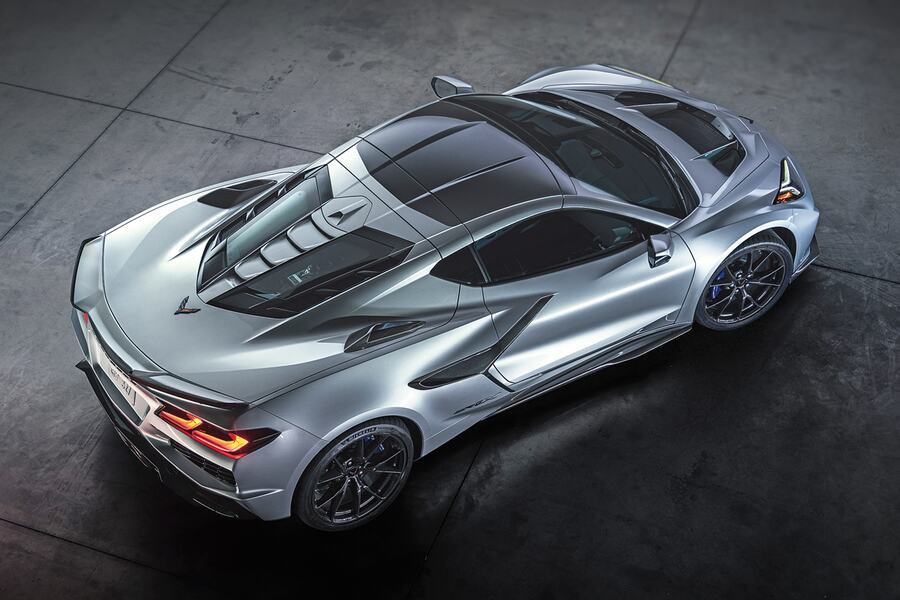The 2025 Corvette ZR1 shreds the back straightaway at Circuit of the Americas, a bat out of hell with a sinister, black, carbon-fiber wing. A mirage of shimmering, 98-degree Texas heat clouds the view of the fast-approaching left-hand corner. But I manage a peek at the digital speedometer through my helmet visor before I bang the brakes: 177 mph. That’s up from 175 mph on the previous go-round, and 173 mph the lap before that.
I’m tempted to shoot for 180 mph, and I think I’ve got just enough runway to do it and still stick the landing. But really, the ZR1 has made its point: This is the fastest, most-furious Corvette in history. With a test-certified top speed of 233 mph and a loopy 1,064 horsepower from its twin-turbocharged LT7 engine—output one might associate with a mega-buck EV or alcohol dragster rather than a gasoline-powered sports car—there won’t be many barroom arguments.
The proof is all around me, including from multitalented Corvette engineers I’m chasing around America’s only dedicated Formula 1 course. Backed by a hazy view of the Austin skyline, COTA is a big-boy circuit with 3.4 miles and 20 turns’ worth of technical challenges and scare-yourself-silly sections. Hot shoes here today include Aaron Link, Chevy’s global vehicle performance manager, who set two ZR1 production-car lap records at Virginia International Raceway. Dead ahead of me on track is Brian Wallace, lead vehicle dynamics engineer, setting the kind of wicked pace that earned him the fastest-ever showroom lap at Road America. Those are just two of the five big-game trophies Vette engineers have bagged at U.S. tracks, knocking off the exotic likes of the McLaren Senna and Porsche GT3 RS.
I’m going to need to up my game. Fortunately, the ZR1 isn’t the hair-trigger terror you might expect from its four-digit horsepower rating and classic rear-drive layout. The new King of the Hill is a surprising sweetheart to drive, despite an engine with more than double the grunt of, say, a C6 Z06 and its 7.0-liter V8.

With launch-controlled, 2.3-second rips from 0-60 mph, quarter-miles in 9.6 seconds at 150 mph, and more sheer grip than Schwarzenegger in his prime, this is a new performance world for Corvette, at a price to match: $174,995 for a ZR1 coupe, with its nostalgic styling nod to a split-window ’63 Sting Ray, or $184,995 for the retractable hardtop convertible. (I’d go for the topless model in a Chevrolet heartbeat, despite its extra weight and the loss of the engine-under-glass view).
From the beginning of development two years ago, when engineers realized 1,000 horsepower was within reach (800 had been an initial target), the ZR1 template was born. A Corvette that was unrelenting,
yet refined. World-beating, yet approachable. My own approach begins with a “standard” ZR1, whose suspension is actually more compliant than that of a C8 Z06. Its Michelin Pilot Sport 4S tires are plenty
suitable for street or track, including 345/25ZR21 inch rears that match the width of the Z06 rubber. Tony Roma, Corvette chief engineer, suspects a majority of buyers will choose this more versatile, street-oriented, wet-weather-capable package. And if you still want that lurid wing and other aerodynamic additions, they can be had via an optional Carbon Aero package.

I warmed up here the previous day in civilian-issue C8 Stingrays. But this ZR1 instantly proves a track commando, ready for any mission, with a V-8 war cry that pierces my helmet and threatens to level the COTA grandstands. This version is the top-speed king, with a subtle, adjustable rear spoiler and smoother aero to generate those 233-mph bona fides—even if no customer ever experiences that pace.
The ZR1 is programmed to allow 8,100 rpm at its Sixth-gear peak of velocity, versus 8,000 rpm in other gears. It’s the result of an epic all-nighter at GM’s Milford Proving Grounds. Engineers rushed to calibrate and validate that bonus 100 rpm, then send a software flash to Papenburg, Germany, in time for GM President Mark Reuss’s epic top-speed run last October.
On a display table, I cradle a turbocharger with a 76mm-radius compressor wheel. Chevy calls it a “maniturbo,” but “manly turbo” may be more like it, with twin units boosting the 5.5-liter engine to a heady 828 pound-feet of torque. An exhaust manifold is cast into the turbo housing for compact packaging and an ultra-short flow path into that compressor.
Versus the Z06’s 5.5-liter, flat-crank LT6, its LT7 sibling gets goodies like unique pistons and featherweight titanium connecting rods. But engineers didn’t just bolt a pair of turbos to that engine and call it a day. For the largest, most-powerful turbos ever fitted to a GM car, eliminating lag became critical. A dynamic anti-lag system can partially close the electric wastegates to preserve 6-7 psi of energy in the turbo circuit (among a nominal peak of 20 psi), even when you charge into corners off-throttle.

So instead of a giant upchuck of tire-melting torque when you jump back on gas, that boost-in-reserve allows beautifully progressive response. The ZR1 is thus neck-snappingly fast, but never unmanageably so. Speed sensors also allow the turbos to run much closer to their physical limit and margin of failure. Just be sure to keep an eye on the gas gauge: The boosted LT7 can chug 93-octane at up to two gallons per minute under heavy throttle, draining the 18.5-gallon tank after just a handful of laps.
By now it’s clear that the standard ZR1 will do any owner proud on track, and leave any number of higher-priced sports cars in its thundering wake. But when I roll into the pits for a fill-up and a breather, I hook up with the real track assassin: a ZR1 with the optional ZTK Track Package.
The winged menace trades a lower 224-mph top speed for a functional body that generates a crushing 1,200 pounds of downforce at top speed. That’s 33 percent more than a Z06. A “flow through” hood is the cheat code here, digging what looks like a bottomless well into the C8’s lengthy bonnet. The big boost in front squash let engineers add more out back to balance things out. Enter that skyscraping rear wing, heavily buttressed to handle massive aero forces.
A carbon-fiber Gurney lip helps suck even more exiting air through the hood. The front dive planes are carbon fiber, as are underbody strakes that replace a standard underwing stall panel to pin the front end to pavement. For ZR1 coupes, ducts atop the rear fenders deliver fresh combustion air, and split-window louvers extract unwanted heat. Every ZR1 gets rear brake scoops. Two new heat exchangers up front boost the total to 15. Finally, ZTK models add 10-percent-stiffer springs and Michelin Pilot Sport Cup 2R tires.

I head back onto the circuit, where the ZTK-equipped model instantly declares itself the ultimate track weapon. I’m soon charging up COTA’s 130-foot-tall front hill toward a blind crest, snaking through esses, and carrying more speed through sweepers at a face-peeling 1.3g of lateral grip, as attested by the onboard Performance Data Recorder.
Michelin’s bespoke Cup 2R tires are four unsung heroes, but allow me to start singing: This near-magical rubber features Aramid fibers embedded in plies, at aerospace-levels of design. The tires combine certified safety and stability at speeds up to 233 mph, with enough performance to smoke all your buddies at track days.
Suddenly it all comes together, all the development and details that Chevy engineers sweated over for the past two years. The Cup 2Rs’ extra grip is palpable and appreciated, an adrenaline shot of speed and confidence for car and pilot alike. I’m immediately leaning harder on those front tires, digger tighter toward apexes and their candy-striped curbs, and getting back on throttle earlier for corner exits that feel more like NASA launches. The sheer explosiveness of the ZR1 is now on vivid display, but so is its forgiving nature. Standard carbon-ceramic brakes are up to this all-day task, even in baking Texas heat and humidity. Their 15.7-inch front rotors are the largest in GM history (for now).
If there’s a mild bummer, it’s that the 2025 ZR1 doesn’t get the smartly redesigned interior found on all 2026 Corvettes, including enlarged screens, easier access to PTM settings and launch control, and a passenger grab handle in place of the C8’s awkward “bridge” of buttons that always seemed to be trying too hard.
I’m back in Austin, marinating in post-COTA bliss, when the Corvette team springs another 2026 surprise. I’m led to a sixth-floor deck of the hotel, where I run into a coupe and convertible with “ZR1X” badges on their spotlighted flanks. Corvette executives call it “The American Hypercar”—a 1,250-horsepower, all-wheel-drive hybrid ZR1 that promises 0-60 mph in less than two seconds. (See accompanying piece.)
It’s been mere hours after my inaugural ZR1 drive, and what does the Corvette team do? They go and top themselves, with a Corvette that directly targets European fastest, and priciest, boutique speed machines. Apparently there are still some records worth pursuing, and cars worth beating.





